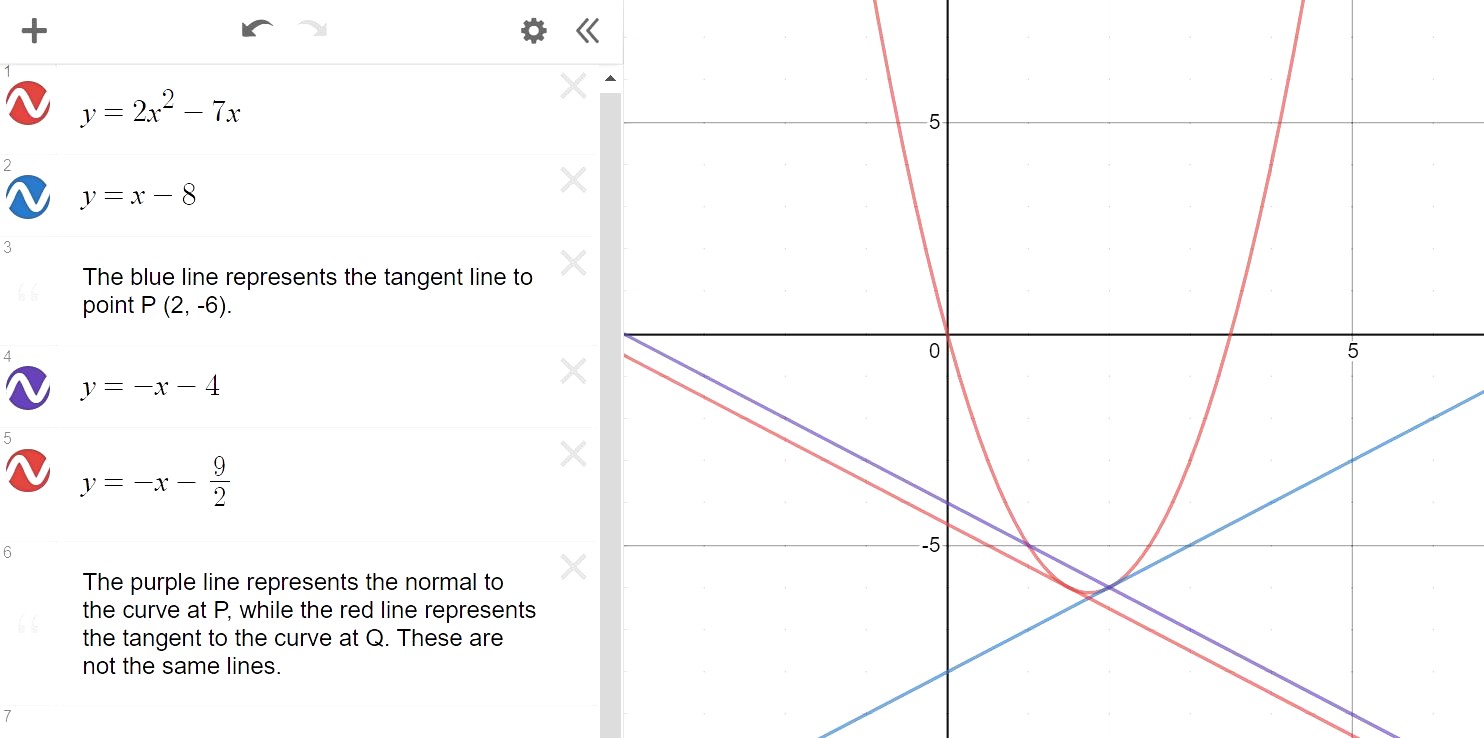Eric Nicholas K's answer to LockB's Secondary 4 A Maths Singapore question.
done
{{ upvoteCount }} Upvotes
clear
{{ downvoteCount * -1 }} Downvotes
LockB, this is a supplement to the Practise Now 2 Q1.
DIfferent points on the curve y = 2x² - 7x will have different gradients and therefore different equations of tangents.
Now, we know that points P and Q will produce clearly different tangential lines, indicated by the blue and red lines in the picture (they do not appear perpendicular to the scaling which I have used, but they are actually perpendicular if drawn to equal scales on both axes).
This is because it is given in the question that the tangent to the curve at Q is perpendicular to the tangent to the curve at P. In short, we simply draw two tangents from two different points so that they meet at right angles.
Note that the tangent to the point Q is not the same as the normal to the curve at P because the tangent to the point Q does not pass point P at all. The normal to the curve at P would need to be perpendicular to the tangent at P and pass through point P (as indicated by the purple line).
--------------------------------------------------------------
So, the purple and red lines are obviously parallel to each other, because we know that
- the normal to the curve at P is, by default, perpendicular to the tangent to the curve at P
- the tangent to the curve at Q is perpendicular to the tangent to the curve at P (given in the question).
But, as explained previously, these are not the same.
When we talk about a normal to the curve, we are strictly referring to that one perpendicular line passing through the tangential point only. Other lines will never be identical to the normal.
The tangent to the curve at point Q, which happens to be perpendicular to the tangent to the curve at P, can just be treated as "any other perpendicular line" when you are looking at point P.
DIfferent points on the curve y = 2x² - 7x will have different gradients and therefore different equations of tangents.
Now, we know that points P and Q will produce clearly different tangential lines, indicated by the blue and red lines in the picture (they do not appear perpendicular to the scaling which I have used, but they are actually perpendicular if drawn to equal scales on both axes).
This is because it is given in the question that the tangent to the curve at Q is perpendicular to the tangent to the curve at P. In short, we simply draw two tangents from two different points so that they meet at right angles.
Note that the tangent to the point Q is not the same as the normal to the curve at P because the tangent to the point Q does not pass point P at all. The normal to the curve at P would need to be perpendicular to the tangent at P and pass through point P (as indicated by the purple line).
--------------------------------------------------------------
So, the purple and red lines are obviously parallel to each other, because we know that
- the normal to the curve at P is, by default, perpendicular to the tangent to the curve at P
- the tangent to the curve at Q is perpendicular to the tangent to the curve at P (given in the question).
But, as explained previously, these are not the same.
When we talk about a normal to the curve, we are strictly referring to that one perpendicular line passing through the tangential point only. Other lines will never be identical to the normal.
The tangent to the curve at point Q, which happens to be perpendicular to the tangent to the curve at P, can just be treated as "any other perpendicular line" when you are looking at point P.
Date Posted:
3 years ago


